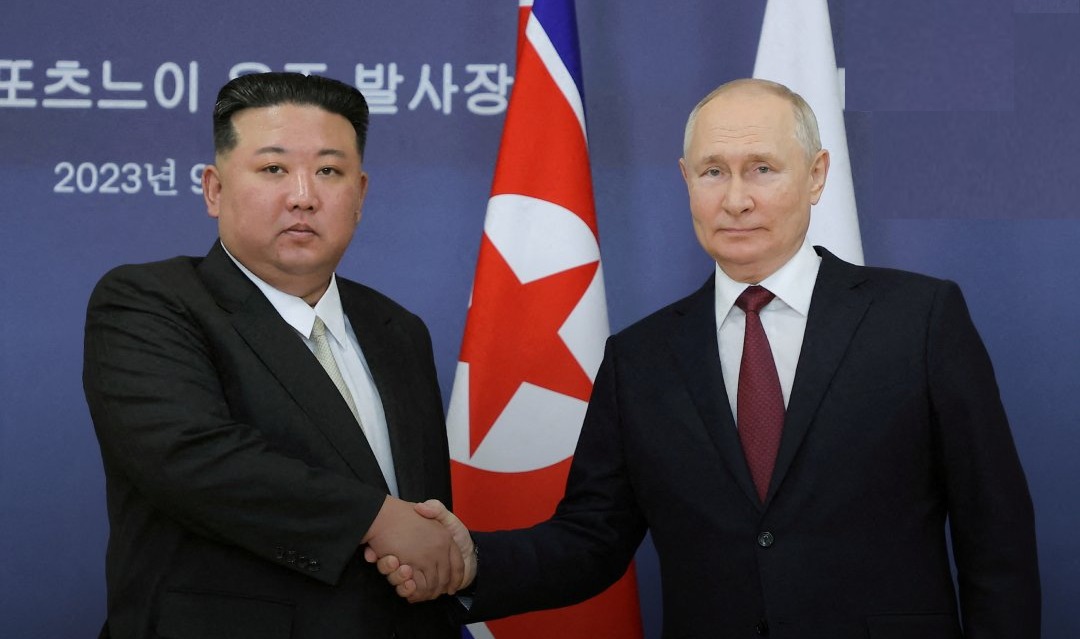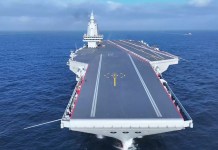In the latest evidence of burgeoning military ties between Russia and North Korea, Moscow’s military forces have reportedly deployed a North Korean-origin anti-tank missile system codenamed ‘Bulsae-4 M-2018,’ signaling a bigger involvement of Pyongyang in the Ukraine War.
The Bulsae-4 M-2018 self-propelled long-range anti-tank guided missile (ATGM) system was reportedly spotted for the first time by Ukrainian forces somewhere in the Kharkiv region. A Ukrainian reconnaissance drone photographed the vehicle, which has gone viral on social media.
The photo was first posted by the KUP Telegram channel, which also noted that the six-wheeled armored vehicle resembled the North Korean Bulsae-4 M-2018. This is the first evidence of a North Korean armored vehicle in Russian service.
Moreover, while there have been other reports of unidentified ATGMs traveling from North Korea to Russia, this seems to be the first time that the exact type of ATGM has been revealed.
EurAsian Times could not independently verify when the system arrived in Russia, but there is widespread evidence that it was shipped in a recent arms package. In June 2024, South Korea reported that it detected at least 10,000 shipping containers being sent from North Korea to Russia.
The Bulsae-4 launcher is a rotating assembly of eight missile containers fixed to the North Korean M-2010 wheeled armored personnel carrier chassis, which is characterized by its unique 2+4 all-wheel drive arrangement.
Surprise! North Korean long-range Bulsae-4 ATGM system spotted for the first time by Ukrainian forces in Kharkiv region.
It is classified as a non-line-of-sight (NLOS) missile system, which allows it to engage targets without the need for direct line-of-sight to the target.… pic.twitter.com/oY9NXxBxsR
— Clash Report (@clashreport) July 30, 2024
The M-2010 armored personnel carrier is a scaled-down variant of the BTR-60/BTR 80. Thanks to its unique wheel configuration and strong diesel engine, the carrier has reasonable cross-country and rough-terrain performance. It is reported to have an operating range of about 500 kilometers and a maximum speed of about 90 kilometers per hour.
As per reports, this anti-tank missile system is categorized as Non-Line-of-Sight (NLOS) and employs an unidentified fiber-optic guided missile system that is intended to hit armored and rotating objects at a distance of more than ten kilometers. In essence, the missile is a top-attack weapon intended to strike an armored vehicle at the point where the vehicle’s defenses are most vulnerable.
As the images of the vehicle went viral on social media, military analysts suggested that the Bulsae-4’s NLOS missiles would give the anti-armor arsenal a new stand-off capability. Some reports noted that the missile works similarly to Israel’s Spike NLOS, whereas others cited similarities with Chinese AFT-10 ATGM.
The specific features of the system remain shrouded in secrecy owing to the general clandestine nature of Pyongyang’s military programs. However, reports suggest that the system allows man-in-the-loop first-person control while in flight, which means the missiles can also be fired and directed in the direction of their target before locking onto it (lock-on after launch).
This implies that the target wouldn’t even have to be in the launcher’s direct line of sight. The missile might navigate around small variations in the landscape and man-made obstructions, making it more likely to hit the designated target.
According to reports in Ukrainian media, the missile is equipped with an electro-optical guiding head that provides the operator with a real-time video feed. This, it is believed, enables it to engage covert targets and avoid obstructions, as well as enable targeting modifications to be made while in flight. Further, the missile’s non-ballistic trajectory increases crew survival by lowering the possibility of radar detection.
Although the development is significant, this is not the first time that a North Korean system has been found in service with Russia and sparked interest.
North Korea’s Military Cooperation With Russia
Russia has already received hundreds of short-range ballistic missiles and millions of artillery ammunition from North Korea.
The first evidence of Russia using North Korean missiles came in early January this year. At the time, Mykhailo Podolyak, a close aide to the Ukrainian President, said, “There is no longer any disguise…as part of its outright genocidal war, the Russian Federation for the first time struck at the territory of Ukraine with missiles received from…North Korea.”
The most popular of these has been the KN-23 which is very similar to the Russian Iskander, albeit with a longer range. Experts have long maintained that Moscow would ask for artillery shells and anti-tank missiles.
Siemon Wezeman, a senior researcher at the Stockholm International Peace Research Institute, said, “North Korea might have had large stocks of ammunition that Russia could use.”

Military watchers surmise that Russia’s deployment of North Korean arms against Ukraine would help Pyongyang collate crucial information about the efficacy of its systems in a real combat situation. However, this also hints at a more indirect North Korean involvement in the war than showcased by the transfer of shells and missiles.
The Bulsae-4 fills an increasing gap for the Russians, who have lost several anti-tank missile systems on the frontline since the beginning of the invasion.
Perhaps this is why such a system has rarely been seen in recent months. Moreover, this could finally be the last straw for South Korea, triggering an arms flow to Ukraine in the future.
Russia’s relations with North Korea, a small, isolated nuclear state, have warmed up dramatically in recent years due to Russia’s rising enmity with the West over the invasion of Ukraine and the suppression of any domestic dissent.
The two countries recently signed a mutual defense agreement that states that they will use all available means to provide immediate military assistance in the event of war.
- Contact the author at sakshi.tiwari9555 (at) gmail.com
- Follow EurAsian Times on Google News




